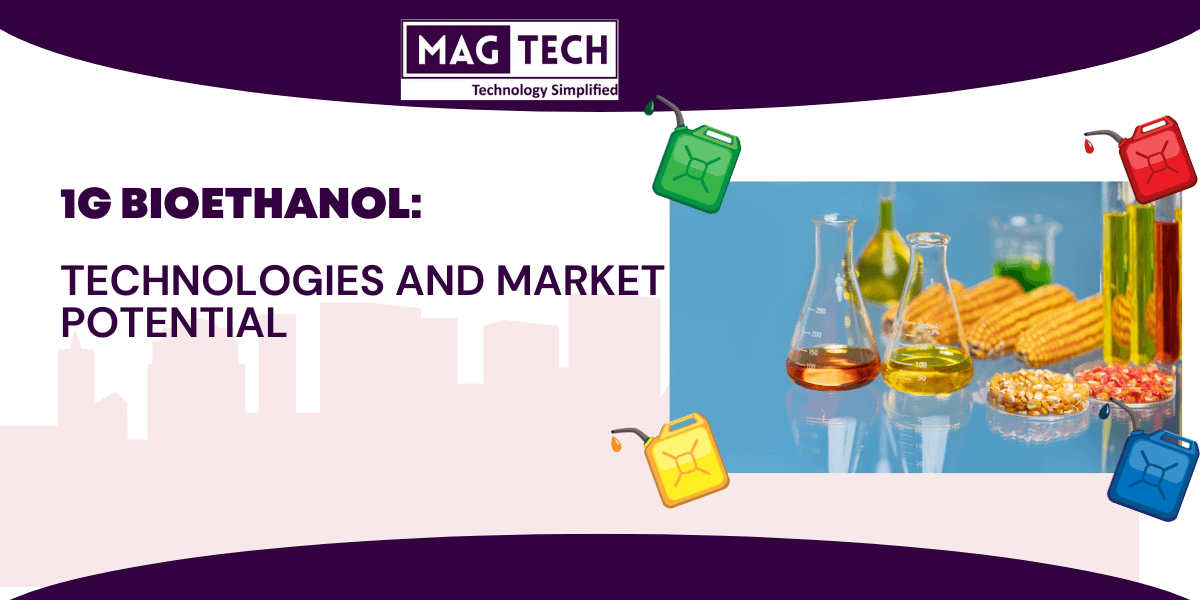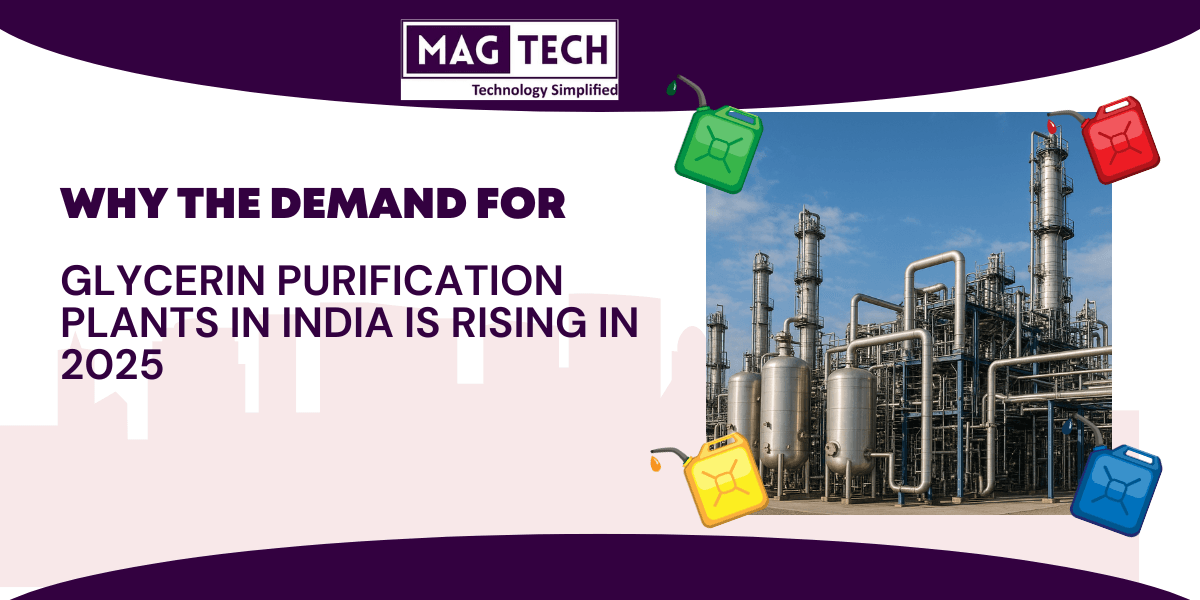Before getting into the topic of Glycerin Purification Challenges, we should know that the Most biodiesel manufacturers prefer to sell crude glycerin, the main byproduct of biodiesel production. However, this byproduct has the potential to open a new window of revenue generation if purified on the premises.
Forecasters expect the global glycerin market to increase at a promising rate of 5.37% from 2023 to 2034. This impressive CAGR is primarily supported by the increasing global demand for glycerin in the pharmaceutical industry.Biodiesel manufacturers often face certain glycerin purification challenges to generate another source of revenue. To understand glycerin purification challenges and future trends, let us take a quick peek into the conventional methods first.
Table of Contents
ToggleContemporary Glycerin Purification Steps in Biodiesel Manufacturing Units
Crude glycerin forms about 10% of the total output. However, impurities like methanol, water, and soap reduce its value, necessitating purification. The process involves several key steps:
1. Pre-treatment: Solid impurities are filtered out, and sulfuric acid breaks down the soap content. A decanter then separates the resulting acid oil layer, ensuring cleaner glycerin for the next stages.
2. Neutralization: A pH adjuster stabilizes the glycerin, bringing it to a neutral pH level for safe handling and further processing.
3. Methanol removal: Heating the glycerin under vacuum eliminates residual methanol, ensuring a safer and purer product.
4. Moisture reduction: A vacuum dryer preheats and dries the glycerin, removing excess water that could hinder its quality.
5. Distillation and evaporation: Distillation separates glycerin from other impurities, while thin-film evaporation removes salts and residual moisture for a refined final product.
Key Challenges of Glycerin Purification in Biodiesel Manufacturing
Purifying glycerin from biodiesel production poses technical and economic challenges. Impurities, energy-intensive processes, degradation risks, and cost constraints make achieving high purity levels a complex and evolving task for manufacturers.
Here is the list of challenges that, consequently, the new purification techniques are trying to eradicate and, furthermore, enhance the output.
- Impurity Complexity:
Crude glycerol contains diverse impurities like methanol, salts, soaps, and fatty acids, each with unique chemical properties. This mixture, therefore, complicates purification, as no single method can, in fact, efficiently remove all contaminants.
- High Energy Consumption:
Techniques like vacuum distillation require significant energy due to glycerol’s high boiling point. This increases costs, particularly for large-scale operations, and creates environmental concerns about energy efficiency and carbon emissions.
- Glycerol Degradation:
High temperatures during purification can degrade glycerol into byproducts like acrolein, reducing yield and quality. Controlling heat exposure is crucial but adds complexity to the process.
- Cost Considerations:
Advanced methods like ion exchange are effective but expensive. Resin costs, regeneration requirements, and handling high-salt content make these methods less economically viable for many manufacturers.
- Feedstock Variability:
The composition of crude glycerol depends on the feedstock used for biodiesel. Variability in impurity levels demands flexible purification strategies, requiring continuous adjustments to maintain efficiency and quality.
- Scaling Up Challenges:
Purification on a large scale is more complex. Managing energy use, impurity removal, and operational efficiency requires optimization, often through costly equipment and detailed process controls.
- Environmental Concerns:
Some purification methods generate significant waste streams, including spent resins and chemical residues. Proper disposal or treatment is necessary to mitigate environmental impacts, adding another layer of complexity.
Biodiesel manufacturers must balance impurity removal, cost efficiency, scalability, and environmental responsibility, all while exploring innovations to enhance processes. For this reason, researchers across the world are actively working on new methods of extracting pure glycerin from biodiesel production waste.
Advantages and Disadvantages of Glycerin Purification Technologies: A Brief Comparison
Here is a concise tabular presentation of the contemporary and new trends of glycerin purification and their challenges.
| Technique | Advantages | Disadvantages |
| Vacuum Distillation (conventional) | High-purity glycerol | High CAPEX and OPEX |
| No pre-treatment needed | Energy-intensive | |
| Good for high salt and MONG content | Not suitable for small plants | |
| Adsorption with Activated Carbon | Removes color and odor | Ineffective for smaller impurities |
| Simple process for polishing | Requires additional filtration steps | |
| Ion-Exchange | Efficient for ion removal | Resin regeneration needed |
| Low energy use | Waste stream cannot be recovered | |
| Widely used in the industry | Only economical for low salt content | |
| Electrodialysis | Continuous process | Requires pre-treatment |
| High yields | Challenges with membrane issues and scaling | |
| Effective ion removal | ||
| Membrane (Thermally-driven) | Achieves high purity | Pore wetting issues |
| Low energy requirements | Limited heat recovery | |
| Can use renewable energy | ||
| Membrane (Pressure-driven) | High flux rate | Fouling from MONG content |
| Economically feasible | Requires high pressure and pre-treatment | |
| Coagulation | Simple one-step process | Large coagulant quantities needed |
| Mild treatment conditions | Sludge must be processed externally |
Table: Advantages and Disadvantages of Glycerin Purification Technologies
Let us now dig deeper to understand these purification technologies and their challenges in detail.
Future Trends of Glycerin Purification and Their Challenges
Different industries need different grades of purity. Achieving this purity at a low cost is the prime aim of these glycerin purification methods being developed.
Waste-based Biogenic Material for Glycerin Adsorption
Adsorption is increasingly used in glycerin purification as a final step to improve color and odor by removing smaller fatty acids. This technique typically uses porous materials, like activated carbon, but there’s a growing focus on waste-based adsorbents like bentonite and tea waste. These materials undergo chemical or physical activation to enhance their adsorption properties.
Challenges:
- Waste generation from activation: Preparing waste-based adsorbents often requires chemicals, leading to additional waste that must be treated.
- Reactivation complexities: Reactivating used adsorbents involves solvents, which further increase waste and processing requirements.
- Scalability issues: Optimized lab conditions may not easily translate to industrial-scale operations, making implementation challenging.
- Environmental concerns: Handling and disposal of waste from the process can pose environmental risks if not managed properly.
- Cost implications: While materials are inexpensive, the overall cost increases due to chemical and solvent requirements for activation and reactivation.
Vacuum Distillation:
Vacuum distillation is an effective method for purifying crude glycerol due to its ability to minimize unwanted reactions caused by high temperatures. By operating under reduced pressure, the boiling point of glycerol decreases, reducing the risk of degradation into undesirable byproducts like acrolein, glycerose, or polyglycerol.
Challenges:
- High energy consumption: Requires significant energy for vaporization and maintaining a high vacuum, increasing operational costs.
- Capital-intensive: Equipment costs make it less viable for small or medium-sized plants.
- Pre-treatment dependency: Highly impure crude glycerol demands additional pre-treatments, raising overall process complexity and expense.
- Low yield risks: Impurities like MONGs and ash can cause clogging at the column bottom, reducing glycerol recovery.
- Operational challenges: Maintaining the extreme vacuum levels achieved in research (e.g., 0.04 mbar) is impractical on an industrial scale
- Degradation risk: At improper pH or temperature conditions, glycerol can degrade into undesirable byproducts, impacting yield and purity.
Ion Exchange Resins:
Ion-exchange resins are commonly used as an additional step in the glycerol purification process, particularly for removing small amounts of salts from the solution. The process involves replacing the cations and anions in crude glycerol with ions present in the resin, producing water as a by-product.
Challenges:
- Limited Suitability for High Salt Content: Ion-exchange resins are less effective and uneconomical when crude glycerol contains more than 5–7% salt due to high chemical regeneration costs.
- Regeneration Complexity: Resins require specific chemicals for regeneration, leading to additional operational steps and costs.
- Process Efficiency: For highly impure glycerol, the method may require pre-treatments.
Coagulation and Flocculation:
Coagulation and flocculation are methods used to remove charged colloidal particles from a suspension by destabilizing and aggregating them, followed by sedimentation. One can apply this technique to remove ions from crude glycerol.
Challenges:
- Limited Research: The method is not fully explored for crude glycerol purification.
- Effectiveness for High Contaminant Levels: Its efficiency may be limited for highly contaminated glycerol.
Membrane Separation Technologies:
Membrane separation technologies are emerging as promising alternatives for purifying crude glycerol due to their energy efficiency and ability to avoid the use of additional chemicals compared to traditional methods like vacuum distillation.
These technologies mainly include pressure-driven and thermally-driven membrane processes, with ongoing research exploring their applications and effectiveness.
1. Pressure-Driven Membrane Separation:
Pressure-driven membrane separation, such as Reverse Osmosis, is widely used to purify glycerin by using pressure to push the liquid through a membrane. However, it faces some challenges:
Challenges:
- Fouling: Glycerin’s viscosity can cause rapid buildup of contaminants on the membrane surface, reducing efficiency and requiring frequent cleaning.
- High Energy Usage: Glycerin’s thick nature, therefore, requires high pressure to push it through the membrane; consequently, this results in higher energy consumption.
- Membrane Lifespan: Constant pressure and cleaning cycles can degrade membranes over time, increasing maintenance costs.
2. Thermally Driven Membrane Separation:
Thermal separation methods, such as Membrane Distillation, use heat to drive the purification of glycerin. While effective, they have their drawbacks:
Challenges:
- Energy Intensity: Heating glycerin for distillation requires substantial energy, increasing operational costs.
- Temperature Control: Maintaining a stable temperature is crucial to avoid membrane damage or impurities in the glycerin.
- Membrane Fouling: High temperatures may cause certain compounds to precipitate, leading to membrane clogging and requiring more maintenance.
3. Electrodialysis:
Electrodialysis uses an electric field to separate ions from glycerin. While it is useful for certain applications, there are several challenges:
Challenges:
- High Electricity Consumption: The energy needed to create an electric field makes electrodialysis energy-intensive.
- Fouling: Like other methods, electrodialysis systems can suffer from fouling, especially due to salts or other charged particles in glycerin.
- Limited Ion Removal: This method is less effective at removing non-ionic contaminants, which can limit glycerin purity.
Inference of New Glycerin Purification Methods: Takeaway
Future research in glycerol purification will focus on developing more cost-effective and efficient methods. As crude glycerol from waste-based biodiesel increases, new solutions are needed to purify it for use in industries like chemicals and raw materials, rather than high-profit areas like food or pharmaceuticals.
Unlock the Potential of Glycerin Purification in Your Biodiesel Plant with MAGTECH
We, at MAGTECH, with over 10 years of experience in biodiesel plant manufacturing, assist our clients in understanding the glycerin purification challenges and future trends. Our expertise ensures efficient, cost-effective solutions tailored to your needs, helping you make the best decision and unlock the full potential of your byproduct.Ready to elevate your biodiesel production? Contact Magtech today to explore how our advanced systems can optimize your glycerin purification process and boost your bottom line.


